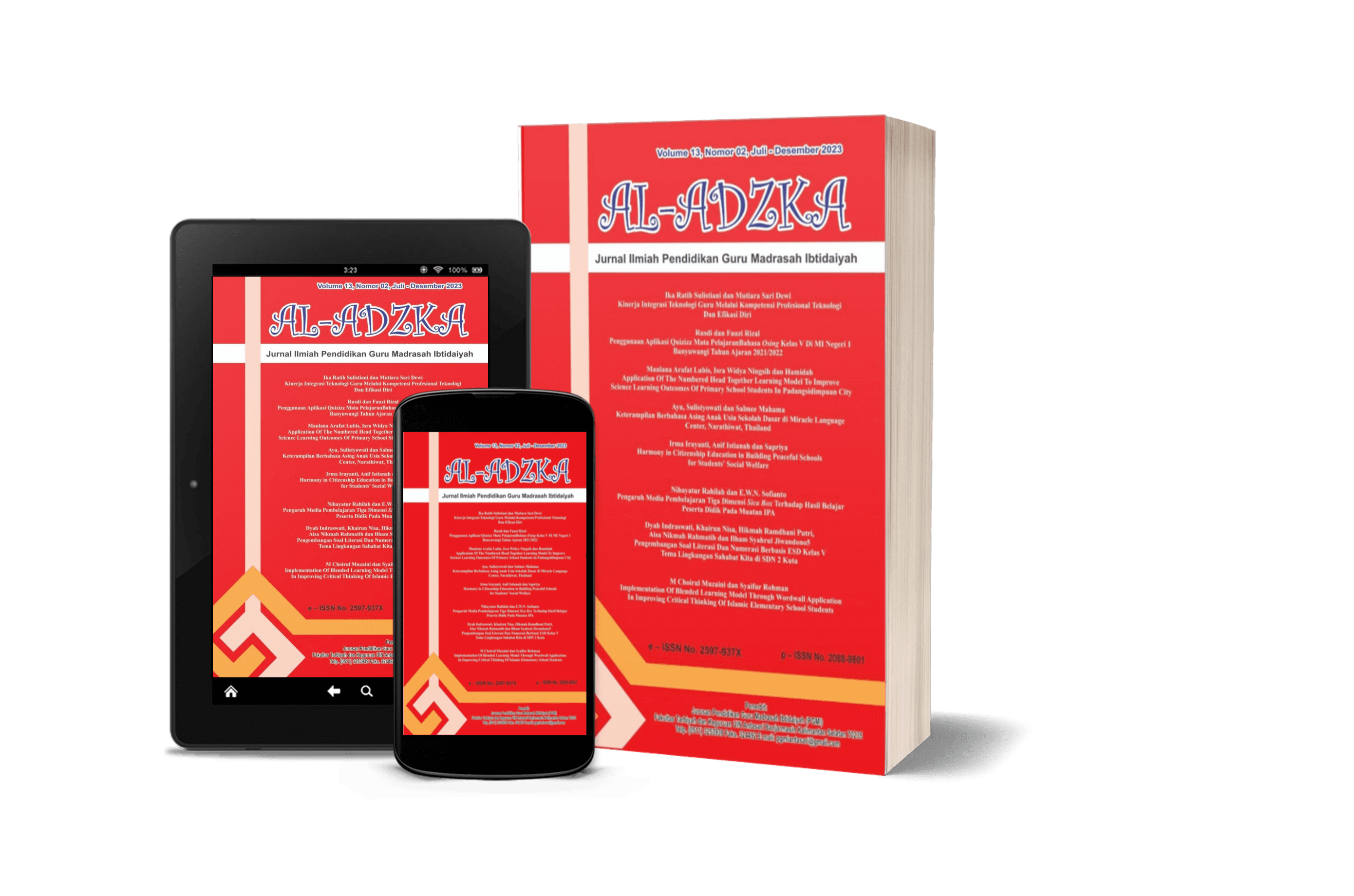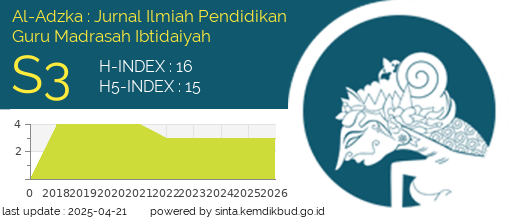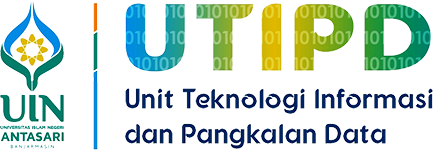Problems in Mathematics Learning Multiple Materials Viewed From Low-Grade Students' Learning Interest Aspect
DOI:
https://doi.org/10.18592/aladzkapgmi.v12i2.6948Keywords:
problematics, mathematics, multiplication, aspects of interest in learningAbstract
This research is motivated by a lack of understanding in learning mathematics multiplication material. This study aims to describe the problems in learning mathematics with multiplication material in terms of the learning interest of low-grade students at SDN 13 Sitiung Dharmasraya. This researcher uses qualitative descriptive research. The research subjects were homeroom teacher for grade 2, homeroom for grade 3, and grade 4 for low-grade students. Data collection techniques by means of observation, interviews, and documentation. The data analysis technique in this study uses the Milles and Huberman model which consists of data collection, data reduction, data presentation, and conclusion drawing/verification. The results showed that the problems in learning mathematics multiplication material can be seen from several factors, one of which is the student's interest in learning, which can be seen from the indicators of student interest in learning, namely, students' feelings of pleasure, attention in learning, lesson materials and teacher attitudes. interesting, the benefits and functions of the subjects. From this, it can increase students' interest in learning mathematics in multiplication material.References
Alhamid, T. (2019). Istrumen Pengumpulan Data Kualitatif. 1–20.
De Porter, Bobbi dan Hernacki, Mike. 1992. Quantum Learning. Membiasakan Belajar Nyaman dan Menyenangkan. Terjemahan oleh Alwiyah Abdurrahman. Bandung: Penerbit Kaifa.
Dwiyono, Y. (2021). Analisis Kesulitan Belajar Operasi Hitung Perkalian Matematika Siswa Kelas IV SDN 019. 1(1858–3105), 1–15.
Fadilla, A. N. (2021). Problematika pembeljaran matematika darig di masa pandemi covid-1. 01(02), 48–60.
Fauziddin. 2014. Pembelajaran PAUD Bermain Cerita Menyanyi Secara Islami. Bandung. PT. Remaja Rosda Karya.
Firmansyah, D. (2015). pengaruh strategi pembelajaran dan minat belajar terhadap hasil belajar matematika. 3, 34–44.
Husaini, Rusdiana, dan Muzdhalifah. (2017). Penggunaan Strategi Role Play dan Strategi Modeling The Way Dalam Pembelajaran Aqidah Akhlak Terhadap Hasil Belajar Siswa kelas IV di MIN Bawah Barabai. AL-ADZKA Jurnal Ilmiah Pendidikan Guru Madrasah Ibtidaiyah, 7 (1), 170.
Kompri. (2016). Motivasi Pembelajaran Perspektif Guru Dan Siswa. PT Remaja Rosdakarya.
Kusuma, Y. E. (2020). Sifat-sifat operasi hitung perkalian bilangan bulat dalam pembelajaran matematika di sekolah dasar. 1, 294–301.
Kusumasari, D. A. (2021). Analisis Kesulitan Belajar Perkalian Pada Siswa Sekolah Dasar Dian Aprilia Kusumasari 1 , Kiswoyo 2 , dan Ryky Mandar Sary 3. 6(I), 104–117.
Lelawarna. (n.d.). Methods Using Napier Bone Students. 11(2), 112–119.
Maulana, I., & Nasution, N. (2020). Jurnal Obsesi : Jurnal Pendidikan Anak Usia Dini Pengenalan Konsep Perkalian Menggunakan Media Rak Telur Rainbow pada Anak Usia Dini Abstrak. 4(2), 512–519. https://doi.org/10.31004/obsesi.v4i2.370
Mz, Z. A., & Vebrianto, R. (2021). Problematika Pembelajaran Matematika di SD Muhammadiyah Kampa Full Day School. 4(1), 95–105.
Nurhasanah, S. (2016). Minat belajar sebagai determinan hasil belajar siswa. 1(1), 128–135.
Nuryati. (2021). Implementasi Teori Perkembangan Kognitif Jean Piaget dalam Pembelajaran Matematika di Sekolah Dasar. 3(2), 153–162.
Rahmi, H. (2012). Metode Horizontal Bagi Anak Tunaruggu. 1, 112–125.
Silalahi,T.M, Pendidikan,F,I, Sari,U, Indonesia, M &Quality,U.2020. Jurnal Mutiara Pendidikan Indonesia Analisis Kesulitan Siswa Pada Pembelajaran Matematika: Studi Kasus Pada Siswa SD Islam.Vol 5(N0.2),25-30
Sirait, E. D. (2016). Pengaruh Minat Belajar Terhadap Prestasi. 6(1), 35–43.
Slameto. (2020). Belajar dan Faktor-Faktor yang Mempengaruhinya. PT RINEKA CIPTA.
Suci, D. W., Barat, S., Padang, U. N., & Barat, S. (2020). Jurnal basicedu. 4(2), 505–512.
Sugiyono. (2016). Metode Penelitian Pendidikan Pedekatan Kuantitatif, Kualitatif, dan R&D. ALFABETA.
Sugiyono. (2019). Metode Penelitian Kuantitatif, Kualitatif dan R &D. ALFABETA,cv.
Sujimat, D. Agus. 2000. Penulisan karya ilmiah. Makalah disampaikan pada pelatihan penelitian bagi guru SLTP Negeri di Kabupaten Sidoarjo tanggal 19 Oktober 2000 (Tidak diterbitkan). MKKS SLTP Negeri Kabupaten Sidoarjo
Sulistyowati Endang. (2014). Penggunaan permainan dalam pembelajaran perkalian di kelas ii sd/mi. 6, 143–158.
Suparno. 2000. Langkah-langkah Penulisan Artikel Ilmiah dalam Saukah, Ali dan Waseso, M.G. 2000. Menulis Artikel untuk Jurnal Ilmiah. Malang: UM Press.
Susati, endang putri. (2020). Strategi Guru Dalam Pembelajaran Berhitung. 10(1), 53–63.
Downloads
Published
How to Cite
Issue
Section
License
Authors who publish with this journal agree to the following terms:
- Authors retain copyright and grant the journal right of first publication with the work simultaneously licensed under a Creative Commons Attribution 4.0 International that allows others to share the work with an acknowledgement of the work's authorship and initial publication in this journal.
- Authors are able to enter into separate, additional contractual arrangements for the non-exclusive distribution of the journal's published version of the work (e.g., post it to an institutional repository or publish it in a book), with an acknowledgement of its initial publication in this journal.
- Authors are permitted and encouraged to post their work online (e.g., in institutional repositories or on their website) prior to and during the submission process, as it can lead to productive exchanges, as well as earlier and greater citation of published work.












